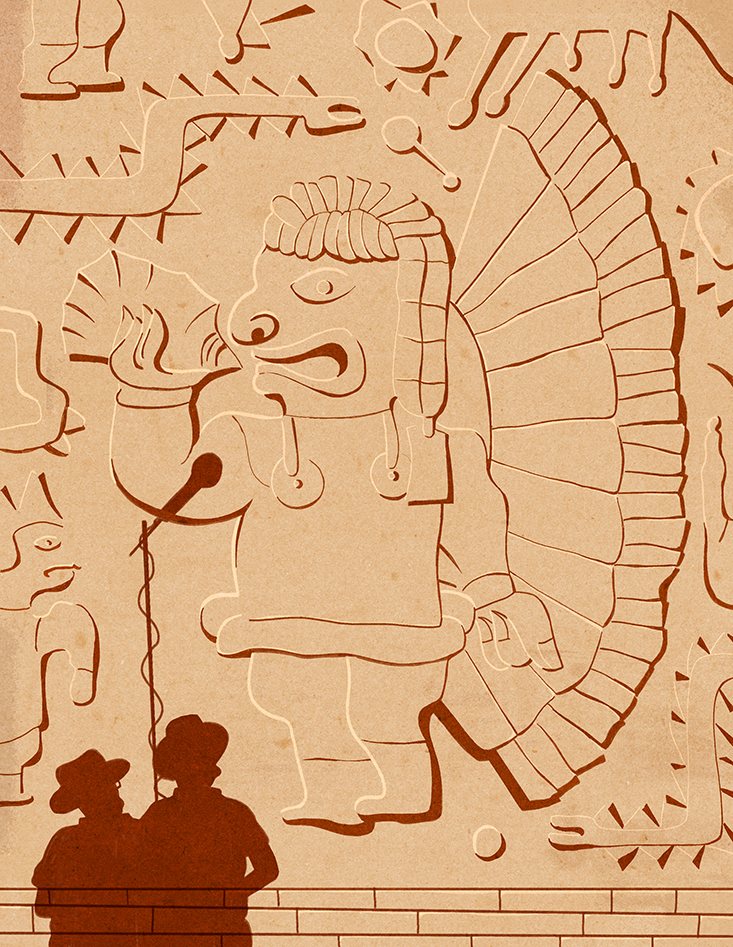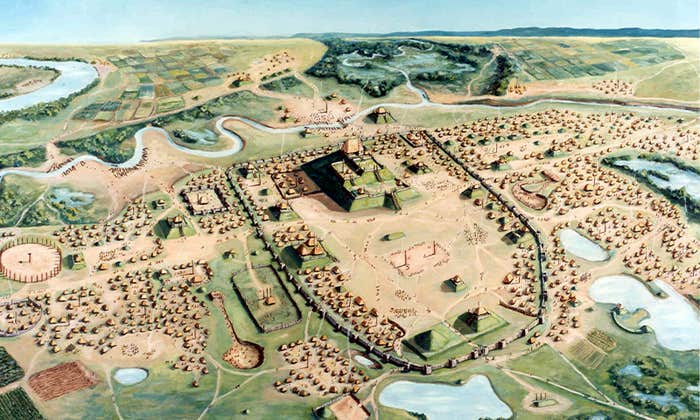Three thousand years ago, an expansive ceremonial complex dominated life in the steep Andean valley of Chavín de Huántar, Peru. It was the center of an enigmatic cult where psychotropic plants were used in transformative rituals. Today, a few imposing buildings remain, their mortared-stone faces towering above multi-level terraces and sunken plazas. Stone, bone, and ceramic artifacts have been found at the site, decorated with striking imagery of fierce animals and zoomorphic humans, but no written texts have been discovered that describe the rituals that took place there.
Ancient people are thought to have consulted an oracle at Chavín, yet until recently, few clues pointed to the nature of this oracle. Now, archaeoacoustic research—sonic science applied to archaeological evidence—has revealed secrets built into Chavín’s architecture, unlocked by the sound of conch shells that were buried for millennia.
I have led archaeoacoustics investigations at Chavín since 2008, when my Stanford-based team visited to test the site acoustics and study its spectacular conch shell trumpets, known as pututus. Dr. John Rick, who has directed research at Chavín since the mid-1990s, invited specialists from Stanford’s Center for Computer Research in Music and Acoustics (CCRMA) to focus on testable scientific aspects of Chavín’s sonic story. Our goal was to understand how sound is shaped and transformed by the site’s architecture and instruments, and to document and explore the material remains of Chavín’s ancient sound environment.
The sensory landscape of Chavín matters because there is evidence that cult leaders used it to establish and enhance their religious authority. Over the four years following our initial survey, I returned to the site develop methods and conduct auditory perceptual experiments with volunteer participants, to test how people perceived its unique acoustics. My discovery of a sound-based oracle was as unexpected as the disorientating effect of entering Chavín’s stony depths.
At first sight, Chavín’s crumbling exterior walls seem impenetrable. Visitors to this Peruvian National Monument and UNESCO World Heritage Site are greeted by stone block buildings partially covered with earth and grass, vestiges of landslides that have ravaged the complex over time. Small rectangular openings along the walls reveal only darkness within. Although more than 20 interior spaces are known, only a few of these so-called galleries are open to tourists. Archaeologists and site conservation staff can navigate off-limit areas, by climbing around fallen slabs of rock or crawling through subterranean canals.
Laberintos Gallery, or the Gallery of the Labyrinths, is named for its maze-like layout. Typical of Chavín’s interior architecture, its narrow corridors turn at right angles, leading to small rooms and dead-end alcoves. In the galleries, footsteps on the packed-earth floors are barely audible, and voices resonate intermittently due to the narrow dimensions, hard stone walls, and immense ceiling beams. Exterior sounds are blocked by meters of stone and musty earth. A visitor’s sense of direction and location is easily confused, especially with respect to the outside world. The air is humid and gritty, punctuated by drafts of fresh air from small ventilation shafts that lead outside. Similar ducts connect many rooms and corridors, and separate galleries.
The sensory landscape of Chavín matters because there is evidence that cult leaders used it to establish and enhance their religious authority.
The galleries are eerily empty, except for one. The Lanzón Gallery protects a 4.5 meter (15 foot) tall granite monolith, a single standing block ornately carved as a humanoid figure with upturned eyes, fangs, and snakes for hair. This Lanzón––“lance-like,” in Spanish––is considered the central Chavín idol, and its oracular symbol.
Located in a tight cross-shaped room at the end of a long tapering corridor, the monolith is hidden away from public view. Outside, a grand staircase flanks its building and fans out into a sunken circular plaza, 21 meters (69 feet) wide. Chavín’s Circular Plaza would have been a key ceremonial locus, perhaps enlivened with the sound of conch trumpets as depicted in two of the stone reliefs along its walls. Tiny square openings on the fragmented walls above the plaza are visitors’ only clue to the vast interior depths that enclose the monolith. For those who do enter its sanctuary, a glimpse of the Lanzón inspires awe, even without knowledge of its ancient religious context.
The work of celebrated Peruvian archaeologist Julio C. Tello in the early 20th century drew attention to Chavín’s importance as an ancient pilgrimage site, a sacred place where ritual took place under elite control. Construction seems to have been continuous for the better part of a millennium, from around 1200 to 500 B.C., at a time when social hierarchies were taking shape across the Andean region.
Chavín demonstrates how a complex society dominated and managed nature in an earthquake-prone, risky environment. Its builders transformed the landscape from the bedrock up: A diverted river, kilometers of subterranean canals, and vista-occluding stone ceremonial buildings cover an alluvial plain where two rivers meet. Extensive planning and command of great resources were necessary to construct Chavín’s multi-level architecture, to chart its underground canals and interlacing ducts. Detailed assessments of Chavín social order include Dr. Luis Lumbreras’ economic interpretation of widespread power structures centered on Chavín, and Rick’s argument for the existence of “an evolved Shamanism.” Certainly, the production of the site’s massive stonework and finely crafted objects required specialists within a social system that harnessed material and labor contributions from a vast geographical region.
Sensory and experiential clues add to the accumulating evidence of an innovative and structured community at Chavín. Some of the decorated stone and bone tools excavated from the site and its surroundings were used to prepare and consume psychoactive plants. Larger-than-life human, animal, and anthro-zoomorphic sculptural stone heads once lined exterior walls, projecting the extreme grimaces, upturned eyes, and nasal mucus trails typical of such plant use. Labyrinthine, deeply enclosed interior spaces—where light could be excluded or manipulated using polished coal mirrors and shadow projections—are hidden within the unyielding buildings.
The Lanzón Gallery protects a 4.5 meter (15 foot) tall granite monolith, a single standing block ornately carved as a humanoid figure with upturned eyes, fangs, and snakes for hair.
Chavín might be described as a theatrical ritual venue. Platforms high above group gathering areas could have been used for leaders’ dramatic and mysterious appearances; secluded rooms would isolate individuals and facilitate psychotropic experiences; a network of subterranean canals thundered with water, mysteriously out of sight. Sensation was elemental at ancient Chavín, and sonic perception is particularly provocative due to its subversive immediacy. Sound creates sensory effects that often can’t be accurately identified. Physical vibrations, heard or felt, influence our emotions, thoughts, and behavior, setting the stage for how we interpret experiences, how we understand places and events.
The first archaeological consideration of sound at Chavín was made in the 1970s, when Peruvian archaeologist Lumbreras and colleagues discovered a slate-lined canal running beneath Chavín’s Circular Plaza staircase. Pouring barrels of water through this so-called acoustic canal created a roaring sound effect for listeners in and around the plaza outside the Lanzón Gallery. In a 1976 article, Lumbreras and co-authors proposed that such sounding architecture could reinforce pilgrims’ religious experiences—potentially related to an oracle—and they estimated other hydraulic sound effects related to the monument’s extensive canal system and interior architecture. They did not conduct more acoustic tests, but they had made an important discovery: Sound could be a powerful tool for Chavín cult leaders.
In 2001, archaeologist Rick and colleagues uncovered a cache of 20 decorated Strombus galeatus conch shell trumpets in a tiny gallery alongside Chavín’s Circular Plaza. These shells had traveled hundreds of kilometers, from the tropical waters off the coast of present-day Ecuador to their resting place in the central Andes. The only sound-making objects excavated from Chavín times, these pututus were also the only sonic instruments clearly depicted in its extensive lithic art. Hand and lip wear indicate that the Chavín pututus were used for generations, and their stunning preservation allows them to be played today. It is difficult to prove that Chavín’s ancient architects designed their buildings with sensory effects in mind—but sound-producing instruments are undoubtedly crafted to stimulate the senses.
Rick knew that the pututus’ sound was an important aspect of their story, so he documented the musical tones they made using the guitar tuner he had on hand. He then sought advice from acousticians and musicologists, while his student, Parker VanValkenburgh, traced their iconography to sites across a large region. Not only had the shells traveled far, but they had been skillfully crafted into soundmakers—musical horns, to be precise—by removing the spires and hollowing out mouthpieces that are similar in shape to a trombone’s. Each pututu bore a unique design, but all were notched in a peculiar manner that appears to be a marker for Chavín.
What secret codes about Chavín might be cut into these shells, either in their decorations or sound? Composer John Chowning wanted to know more. At Rick’s request, Chowning called on his CCRMA colleagues to investigate, and our research project began. A few months later, we were breathing Chavín’s dry, thin air at 3,180 meters’ altitude (10,430 feet), setting up audio equipment to record the pututus in a small room at Chavín’s National Museum.

With Dr. Perry Cook playing the shells, we documented how the physical characteristics of the instruments make sound. Using miniature microphones placed inside and around each shell, we mapped how sound passes through and radiates around the pututus. Dr. Jonathan Abel, who led acoustic data analysis efforts back at Stanford, had developed techniques that could translate these measurements into computer models of the instruments to digitally preserve their acoustics. Cook’s analysis showed that the sounding tones of the pututus are between 272 hertz (Hz) and 340 Hz—or from approximately “middle” C#4 to F4 on a piano, a musical reference that makes sense to present-day readers, but would have no relevance to Chavín culture.
Some of the decorated stone and bone tools excavated from the site and its surroundings were used to prepare and consume psychoactive plants.
The Peruvian master musician Tito La Rosa joined our investigation of the pututus. While we worked as scientists, he offered an intuitive artist’s perspective, helping us to understand the range of playing techniques and sounds that a versatile performer could elicit from the instruments. Tito’s reverence for the pututus reminded us that there was a spiritual component that we couldn’t capture with our equipment. Tito blew a whisper through the most ornate of the ancient conchs, setting off toneless echoes in the voluminous concrete space of the Chavín museum. A fluid tone emerged from silence, undulating around a low pitch, and building in volume.1 The pututu’s peal seemed unworldly, part human, part animal, from another time and place.
Although pututus are the only musical instruments found at Chavín to date, it’s probable that other soundmakers would have been played in ancient rituals. To test how Chavín architecture responds to a variety of likely candidates, we asked Tito to bring musical instruments on site with us to make tests according to musical and engineering intuition. In and around the plazas, atop buildings, and within the galleries, we played and listened to an assortment of pututus, flutes of bone, feather, and ceramic, ocarinas and other whistles, rattles, zampoñas, and even a charango, the paired-string Andean lute that resembles a miniature guitar.
Archaeoacoustic methods give us a way to identify and objectively describe Chavín’s environmental sonics, whose effects may have been intensified for ritual participants by the use of plant-based psychotropics. Beyond first-hand sonic tests—like performing a replica pututu in a Chavín plaza—and the identification of obvious sound effects—such as initiating echoes among building faces and surrounding hillsides—acoustic measurements made using test signals, loudspeakers, microphones, and recording devices can map how sound is transmitted and transformed by architecture. It was using a combination of these techniques that I discovered that the vibratory frequencies of the pututus could make the Lanzón speak.
Visitors to Chavín sometimes notice that gallery architecture transforms sound in surprising ways. Small horizontal ducts allow sound to travel between seemingly separate corridors, rooms, and cells. Depending on the shape, length, and architectural context of these ducts, sound that passes through is filtered or “EQ-ed,” producing a range of effects. I began documenting and measuring the acoustics of Chavín’s so-called ventilation shafts during the 2009 archaeological field season, usually solo, occasionally with an assistant to help manage gear between interior and exterior openings.
During my first visit to the Lanzón Gallery, I had noticed that the carved mouth of the monolith aligned perfectly with one of the ventilation shafts that led from the gallery out to the Circular Plaza. Rick had previously tested the effect of light passing through this duct, and had concluded that it could be used to illuminate the face of the Lanzón. But no one had considered the symbolic “line-of-speech” it creates.
This central “line-of-speech” duct is flanked by two parallel ducts, each of slightly different proportions. I designed a series of tests to examine how sound made within the gallery is transformed on the way out through the ducts, using frequencies within the range of human hearing (about 20 Hz to 20,000 Hz). From different locations within the Lanzón Gallery, I used precision loudspeakers and a subwoofer to reproduce mathematically generated test signals. A series of microphones inside the ducts tracked acoustic changes as the sound traveled through. I repeated these measurements several times, and on different days.
I was shocked by the significance of the consistent results. My measurements showed that these ducts were perfect amplifiers for the Chavín pututus. Compared with other sounds, frequencies corresponding to the conch tones were boosted by 10-20 decibels (adding 10 decibels sounds like turning up the volume twice as loud) after sound entered the ducts.2 Once sound reached the exterior ends, where the ducts opened above the Circular Plaza, non-pututu frequencies were suppressed even further. The central duct was not only a symbolic extension from the mouth of the Lanzón, but a functional “line-of-speech” between the carved mouth of the idol and the ceremonial plaza outside. The oracle could be made to speak through the voice of the conch.
The acoustic link between the Lanzón Gallery ducts and the site-excavated pututus is a rare dynamic relationship that’s difficult to dismiss as coincidence. First, Chavín’s architecture is thoroughly channeled with ducts of various shapes and sizes. It seems likely, therefore, that the shape and placement of these particular ducts reflects planned construction: in a word, design.
Second, the location of these sound conduits—between the stone monolith and the plaza—is ritually significant. Pututus are depicted, as if performed by figures in procession, on stone reliefs lining the north-western wall of the Circular Plaza, just a few meters below where the ducts project. The plaza floor was crafted with two inlays of fossilized sea snails on its paving stones, spiraled animals that appear like cross-sectioned pututus. A few meters south, a plausible pututu storage location exists: in the Caracolas Gallery, they were deposited as if they had been hung along its walls.
This constellation of factors points to ancient ceremony not only enlivened by the sound of these horns, but focused on them. The building projects the sound of the pututus—and excludes other sounds—from the mouth of its “oracle” to listeners outside. The code of the conch may be pivotal in generating new theories about Chavín ritual: why would its oracle be voiced by pututus?
Sound—because it’s experiential—is an ephemeral artifact of spaces and objects that we can use to better understand past life. Hearing the echoes of a replica pututu circling around Chavín’s valley can’t transmit cultural meanings from the past, but it can help the listener appreciate the dynamics of a setting that influenced ancient human activity. Performing a replica shell horn inside Chavín’s galleries, I could feel the resonances between instrument and architecture, a physically and emotionally transformative experience that would have been similarly sensed—but interpreted differently—by humans in the past.
Scientific techniques can use material evidence to reveal less obvious aspects of sound that are fundamental to human experience. Sound, measured and modeled between buildings and across spaces, indicates how people might have communicated in ancient Chavín. Acoustic measurements have demonstrated that Chavín’s pututus are dynamically linked to its awesome Lanzón monolith: Instruments and architecture together make an oracular mechanism that projected secrets from the restricted depths of the site to its public gathering areas.
Archaeoacoustics research at Chavín continues. With every discovery, we understand more about the ancient ceremonial context, and by extension, the social implications of sound for people of the ancient Andes. The sound of hard evidence—Chavín’s carved shell and mortared stone—unlocks secrets from the past.
Miriam Kolar studies the human perception of sound in cultural contexts. Her new research explores the potential of auralizations for scholarship and public interfacing, engaging issues of virtual reconstruction and knowledge representation.
Text was adapted by Miriam Kolar from her essay published in Issue 7 of The Appendix, “Tuned to the Senses: An Archaeoacoustic Perspective on Ancient Chavín.”
Footnotes
1. This is a multitrack recording of Peruvian musician Tito La Rosa playing two of the Chavín pututus made during an approved archaeoacoustics research session in the Museo Nacional Chavín, September 2008.
2. This research is detailed in the overview of Chavín archaeoacoustics: Kolar, Miriam A., with Rick, John W. / Cook, Perry R. / Abel, Jonathan S. (2012) Ancient Pututus Contextualized: Integrative Archaeoacoustics at Chavín de Huántar, Perú. In Flower World: Music Archaeology of the Americas, Vol. 1 (Matthias Stöckli / Arnd Adje Both, eds.), 23-54. Ekho Verlag, Berlin.


























